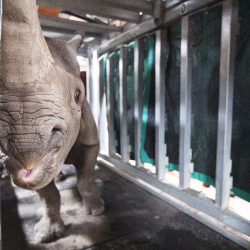This January, students from the MSU College of Veterinary Medicine worked with students from the Universidad Nacional Autónomo de México to provide veterinary care to equids in various communities.
Day 1
By Dr. Hal Schott
Twenty-one hours to get to the Veracruz Ranch—it was not supposed to take this long to travel. That’s one of the reasons we chose Mexico over Africa! The early hours of Sunday morning were dense with fog as I slowly started my way around East Lansing at 3:00 a.m. to pick up Andrea, Lauren, Emily, and Jackie. Then, we headed to the Flint Airport—a bit slower than usual, due to the fog—and arrived about 4:45 a.m. for our 6:00 a.m. flight to Atlanta.
Olivia and Alex met us at the airport, and Sam and MacKenzie were already in Mexico City after completing another welfare clerkship focused on small animals on the west coast of Mexico (Manzunte project). We boarded the plane and sat (and sat) at the end of the runway until they finally unloaded us again about 8:30 due to the fog that refused to lift. Finally, at about 9:30, we reboarded the plane and headed to Atlanta. We had missed our original connection, but made a mad dash to catch a 12:10 flight and arrived at the gate just as boarding was ending. Most of our checked bags made it to Mexico City, except for Alex's, Lauren's, and Emily’s bags.
While they were sorting out where to have their bags forwarded to, I sent Andrea, Jackie, and Olivia through customs (with some syringes and detomidine tucked into their luggage). I headed to customs inspection after reporting that we were bringing medical equipment into Mexico. The customs official had no problem with vaccines, gloves, or dental and farrier equipment—but 700 needles and syringes to administer the vaccines were confiscated. For some reason, the officials had to count them one by one and they messed up the initial count, and dumped them all back on the table for a recount as 45 minutes slipped by.
Finally, by about 4:45 p.m., we had all cleared customs and settled down for a late lunch/early dinner in the airport with our Universidad Nacional Autónomo de México (UNAM) and Donkey Sanctuary colleagues. Then, we loaded up in a UNAM van and a couple of cars for the five hour trek to the Veracruz UNAM Ranch. But who could complain with nice weather, blue skies, the Iztaccíhuatl and Popocatépetl volcanos in the distance, and a nice sunset looking back toward Mexico City?
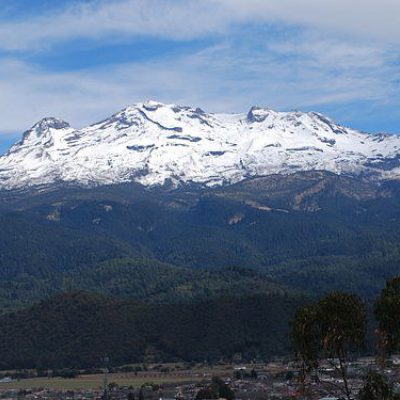
Legend has it that Iztaccíhuatl was a princess who fell in love with one of her father's warriors, Popocatépetl. The emperor sent Popocatépetl to war, promising Iztaccíhuatl as his wife when he returned (which Iztaccíhuatl's father presumed he would not). Iztaccíhuatl was falsely told Popocatépetl had died in battle, and believing the news, she died of grief. When Popocatépetl returned to find his love dead, he took her body to a spot outside Tenochtitlan and kneeled by her grave. The gods covered them with snow and changed them into mountains.
We finally arrived at the Veracruz ranch and settled into our rooms quickly for bed. Despite lost luggage and a long day, there were no complaints as we were enjoying a warm evening and a star-filled sky.
Day 2
By Sam Gamble
We woke up this morning to the sounds of local critters (geckos and birds) of the Centro de Enseñanza, Investigación, y Extensión en Ganadería Tropical (CEIEGT or Veracruz UNAM Ranch), which is where we were staying for the initial part of our trip. The ranch was beautiful, with lush green pastures, palm trees, a river, and mountains in the distance. We loaded up into the Donkey Sanctuary vans to head to breakfast at a local restaurant. It was nice sitting down with the Donkey Sanctuary team and the UNAM students and interns and getting to know them. We learned that several students were in the community service portion of their final term, a mandatory part of their training during which time they work on a variety of projects, largely in rural communities all over Mexico. Interestingly, some of the Donkey Sanctuary staff were not veterinarians, but also included an anthropologist and a sociologist (Humberto and Jose Antonio), emphasizing the holistic philosophy of the Donkey Sanctuary in community service. Everyone at the breakfast table tried to learn a little more about one another, including their interests in school, where they were from, and their experience with equids. It was nice to learn many of the team members' names and get to know them a little bit while enjoying some amazing Mexican food.

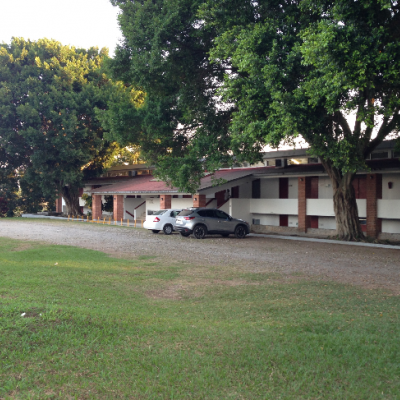
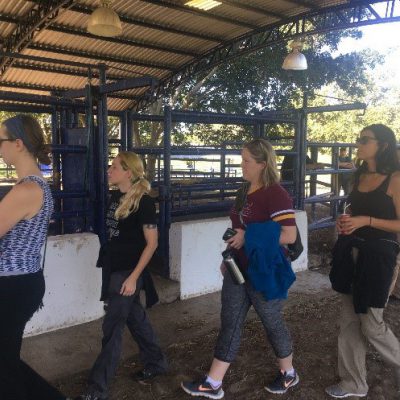
Following breakfast, we loaded back up into the vans and headed back to the Donkey Sanctuary headquarters and administrative office at the UNAM Ranch where we were introduced to “The General,” who was the primary veterinarian in charge at this location, and Humberto, the anthropologist who also works at this location. We learned that in each Donkey Sanctuary location, there is a team of veterinarians, sociologists, and anthropologists that work together in the communities to not only provide veterinary care, but to really learn from the people in the community about their culture, daily lives, needs, and animal welfare concerns. I think we all found this approach admirable and refreshing that veterinarians and social scientists were working together for the greater good of both the people and their animals within the community. The Donkey Sanctuary staff emphasized the importance of understanding the community in order to provide the best veterinary care possible. The staff also mentioned how they use the headquarters to host international students, interns, and veterinarians from around the world who come to work at the Donkey Sanctuary. The United Kingdom, Nicaragua, and various regions of Mexico were mentioned as examples of countries that have participated. Michigan can now be added to this list!
Following our visit to the Donkey Sanctuary headquarters, we had a tour of the Veracruz UNAM Ranch. It consisted of a number of lush pastures where various breeds of cross-bred Zebu and Fresian cattle were grazing, as well as a few horses and sheep. There also is an aquaculture facility here where a UNAM-patented tilapia variant is raised for commercial use. The tour also included a stop at a cattle sorting/processing facility that had been designed by Temple Grandin when she visited the ranch more than 20 years ago.
We ended up at the Education Building where we learned more about our MSU-UNAM Equine Welfare in Practice project from Donkey Sanctuary staff. Once in the classroom, we distributed t-shirts that we had made for the project and took the time to go around the room and introduce ourselves. Many of the Donkey Sanctuary staff and the UNAM students could understand English, and some also could speak English fairly well, but we also had Jose Antonio interpret, which was incredibly useful for the whole team. Many of the UNAM students said they would like to learn more English, and the MSU students also said that they would like to learn more Spanish, so this project is a great opportunity for everyone. Introductions taught us more about one another, including interests and roles with UNAM and the Donkey Sanctuary.
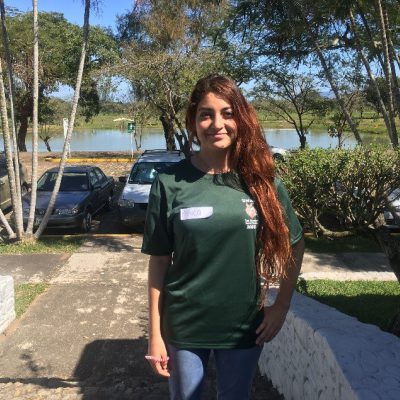
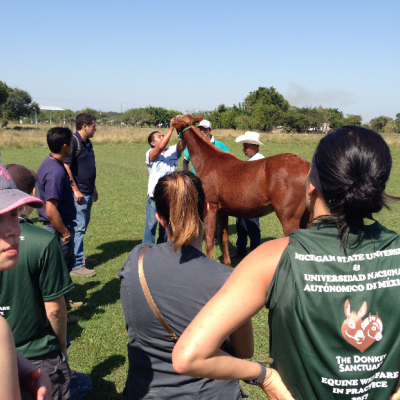
We began the education program by watching a short video in which children from rural communities were interviewed about the role of their working equids. Their answers included carrying loads (water, wood, produce, etc.), transportation, and companionship; one child called his donkey his “best friend.” This video truly emphasized the importance of the human-equid relationship in many communities. The first lecture was given by Dr. Mariano Hernadez Gil, a veterinarian from UNAM who provided good information about the roles of working equids in communities. He made a great point about how easy it can be to have “false” perceptions. As an example, he showed a picture of a girl with a stick standing next to her donkey. He mentioned that people may think she used the stick to beat her donkey, but when she was asked why she had the stick, the girl replied that she needed it to keep away dogs that might attack her donkey. This was a great example about the importance of communicating with owners and not jumping to conclusions. Dr. Mariano also mentioned how important educating the community is, and that the goal of the Donkey Sanctuary is not only to provide intermittent veterinary care, but also to help the community learn how to best manage their working equids for optimal health and productivity.
The next lecture on welfare was given by Dr. Eduardo Santurtun Oliveros. He talked about how welfare has many components, including observation for behavior (including owner interactions), recognition and prevention of pain, and provision of veterinary care. Dr. Eduardo introduced us to a welfare model developed by the Donkey Sanctuary that is represented by a hand. The five fingers represent behavior (including interactions with the owner/handler), body condition, wounds, lameness, and general health. Dr. Eduardo also emphasized the importance of understanding the economic status and needs of the animal owners within each community to tailor education about equine welfare to each community served by the Donkey Sanctuary.
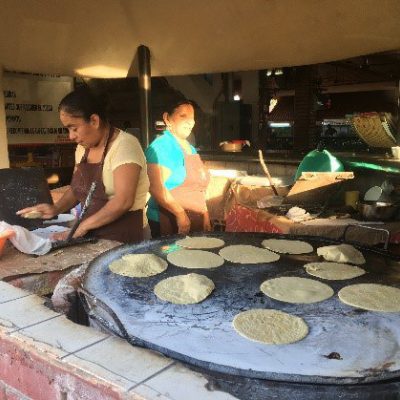
After the lectures, we headed to a local restaurant for a late lunch—carne asada (barbecued beef, pork, and chicken) was served family-style with homemade tortillas—all part of the cultural experience of the clerkship!
After our meal, we headed to a local ranch owned by Reuben Vargus, a friend of Dr. Mariano’s. We spent the early evening learning more from the Donkey Sanctuary staff. Mauro, the behavior expert, described the differences in behavior of donkeys, horses, and mules. We all were somewhat familiar with horse behavior, but donkeys and mules are different. Donkeys often refuse to move and ear holds are useless on these critters, while mules react with lightning speed and can kick you almost anywhere you stand (just ask Jackie). Mauro then demonstrated how he assesses behavior and interacts with young horses by working with a couple of young horses in a round pen. A couple of cars had to be used to illuminate Mauro and the horses in the headlights and Jose Antonio’s (the Donkey Sanctuary sociologist that had a dual role as our primary interpreter for the project) voice was getting a bit hoarse, both indicators that it was time to call it a day. We headed back to the UNAM ranch for the evening.
Day 3
By Jackie Dessoliers
After a group breakfast at what was going to be our breakfast buffet spot for the next few days, we headed back to the Vargus Ranch for a second day of education before we started work in the communities. Dr. Mariano started the day by talking about conformation with a friendly horse and differences between horses, donkeys, and mules. Because of differences in body length between these equid types, UNAM and Donkey Sanctuary staff have developed formulas for estimating body weight in the field using girth circumference and body (shoulder to tuber ischia) length. We decided to further validate these formulas during our community work. Dr. Mariano also emphasized the importance of a complete physical exam, with a particular focus on evaluating potential pain in working equids.

After this demonstration, Luis Aguilar, the Donkey Sanctuary’s harness and saddle fitting expert, talked about wounds and other problems that can develop from poor-fitting saddles, harnesses, and bits. He emphasized that one saddle or harness does not fit all, especially with the different body conformations of horses, donkeys, and mules. He showed how saddles and harnesses are appropriately fitted to working equids, and talked about the impact that different types of work may have (e.g., whether equids are carrying people or loads on their backs or pulling carts). Back pain and wounds over the withers and dorsal spinous processes along the back are common with improper saddle and harness fits, while improper bit placement can cause ulcers in the mouth and lacerations of the commissures of the lips or on the tongue. Many working equids have patches of white hair along the withers or back, indicative of prior wounds that have healed, but these areas may still be painful when pressure is applied. To illustrate some of these problems, Luis made us perform an exercise where students acted as the loaded equids. He helped us understand the importance of distributing weight using a singletree when pulling a load or by dissipating pressure points by distributing loads over a larger surface area. He also told us that many owners misinterpret equids' signs of pain during work as “bad” behavior, resulting in a viscous cycle of more discipline (beating with a stick) and further injury. One of Luis’ primary duties is to educate equid owners in communities on how to properly fit saddles, harnesses, and bits to prevent injuries from happening.
After Luis’ demonstration, Dr. Elena Garcia-Seco, an equine surgeon at UNAM, reviewed assessment of lameness. This was a true “hands-on” experience, as a load of new saddle horses arrived at Reuben’s ranch in the afternoon. MSU and UNAM interns/students were paired up, and each group had a horse to examine. Dr. Elena started the exercise by making them pick up front and hind limbs, palpate the structures of each limb, apply hoof testers, and watch each horse jog for lameness. It warrants mention that these horses were not fully broke, and a couple of times one got loose and galloped around the ranch—fortunately, the ranch was surrounded by a wall. Although we may not have recognized it at the time, this was a good introduction to what we were going to be seeing in some of the communities with working equids over the coming days. All the while we were busy with these exams, we also were distracted by dogs, peacocks, several pigs, and a laminitic horse that were freely roaming through Reuben’s ranch area that we were working in—another welcome to the uncontrollable environments we would be working in over the next days. After we completed these exams without injury (to the horses or students), we had a break and gathered around a couple of tables to devour some great Mexican food provided by Reuben as a thank you.
The next discussion was a review of some infectious diseases that we might possibly encounter (hopefully not), led by Dr. Schott. We reviewed the diseases for which we had brought vaccines for: tetanus, EEE, VEE, WNV, and rabies. The encephalitides (EEE, VEE, WNV, and rabies) are present in Mexico, but surveillance programs are not as well developed as in the US; consequently, true prevalence of these diseases is not well documented. As our discussion wound down, Reuben had a friend present us with a horse that had collapsed during exercise about six months ago. The episode of collapse had occurred on a very hot and humid day, and we worked through some differential diagnoses and we were most suspicious of anhidrosis. Luckily, this horse seemed to have recovered after being out of work for the past six months, as it had a good sweating response while being ridden today. This was a great example of a tropical disorder that we would not likely see back home in Michigan.
In return for Reuben’s generosity of letting us use his ranch and horses as a teaching lab, we spent the rest of the afternoon and early evening hours vaccinating his horses and performing dental exams. We performed dentistry on several animals, and as the day was ending, we watched Dr. Arturo trim and bandage the front feet of the laminitic horse that had been wandering the property. About that time, we were getting hungry, but also noted a few red spots on our exposed arms—we had been attacked by tiny mosquitos, or chiggers (we were never sure), and would be very itchy over the next few days. Oh well, just another surprise of the tropics.
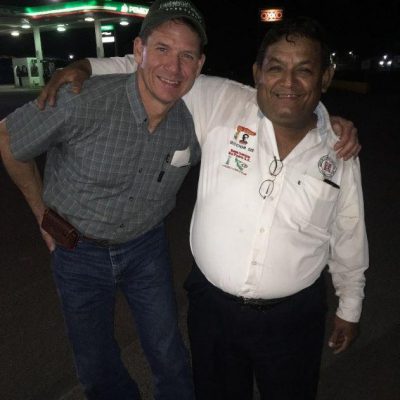
Before we headed to dinner, we had to pick up Dr. Jeff Bunn (Equine Medical, LLC in Lowell, MI), who had flown into Veracruz late that afternoon to join our group. Dr. Bunn was very concerned about whether or not there would be transport at the airport, and, after several last minute changes and frantic texts and phone calls, a professor from the veterinary school in Veracruz met Dr. Bunn and then delivered him to Pepe in Veracruz city, a taxi driver who drove him 2–3 hours to meet up with us. Fortunately, it all worked out, and we retrieved Dr. Bunn from Pepe at the Pemex gas station in Martinez at about 9:00 p.m.
It was serendipity that Dr. Bunn joined our project, as he had recently taken a couple of Spanish classes to help him communicate with grooms on several of the horse farms in his practice. When Dr. Schott sent an e-mail inviting Michigan practitioners to consider joining the project, Dr. Bunn jumped at the chance (perhaps without thinking it through completely). He was certainly happy to see us pull into the Pemex station that evening, and then we all headed to a simple but great local restaurant for traditional Mexican food and cervezas.
Day 4
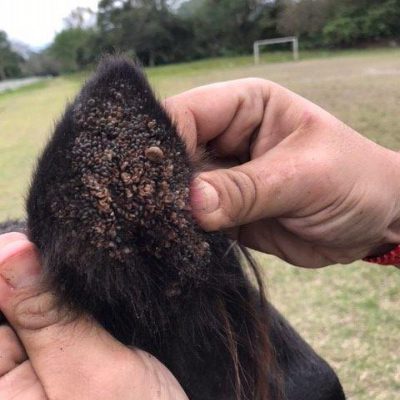
By Andrea Mussara
Today was the first day of field work. After breakfast, we drove about two hours to the community of San Sebastián, Veracruz. When we arrived, there were many equids waiting for us. After a short hands-on demonstration of the evaluation process by Dr. Eduardo and the General, we divided into stations and started evaluating the animals. Sociologists and anthropologists with the Donkey Sanctuary also were on-site to help the equid owners understand how improving the welfare and health of their animals can benefit the family economically.
The first station involved evaluating the health and welfare of the animals and performing a physical exam using the Donkey Sanctuary hand model. Based on the results of this initial evaluation, vaccinations and dewormers were administered, and other procedures were recommended as necessary, with animals sent to a dental care station, harness fitting station, farrier station, and/or castration station. Each station was overseen by a veterinarian and had at least two veterinary students, one from Michigan State and one from UNAM.
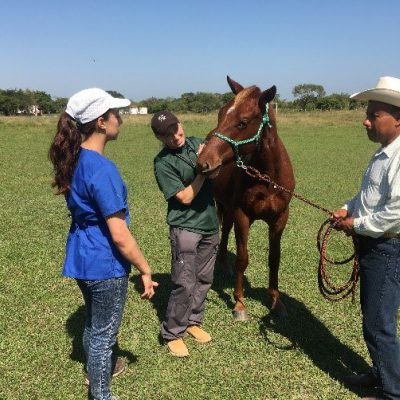
Most of the equids at San Sebastián that came to the clinic were horses with a smaller number of donkeys. The animals were generally in good body condition, and most of the animals were used for transporting people and herding cattle. One of the most common problems we saw was external parasitism with ticks. Many animals also needed dental care and farrier work. The UNAM students were helpful with interpretation and explanation of local customs and traditions involving the animals. All in all, we evaluated about 100 animals in San Sebastián—under a bright blue sky, which all Michiganders appreciated, despite sweating quite a bit through the day.
After we finished working as the sun was setting, all 24 of us were invited to a local family’s home for dinner. They prepared a meal with homemade tamales, a spicy chicken stew, and rice. Unfortunately, we couldn’t stay for long because we also had a traditional barbacoa (barbecue) meal waiting for us back at Reuben’s ranch. The barbacoa consisted of a lamb that had been wrapped in banana leaves and slow-roasted all day in a traditional brick oven over wood coals. A big pot with water and vegetables was placed on the coals under the lambs to catch all the juices, which made a soup to accompany the lamb. It was a delicious meal and a truly traditional experience of rural Mexican culture. After dinner, we ended the day by each person saying what they enjoyed most about the day and what we hoped to learn going forward during the project. It was after 1:00 a.m. by the time we returned to the UNAM ranch, and all were exhausted after our first day!
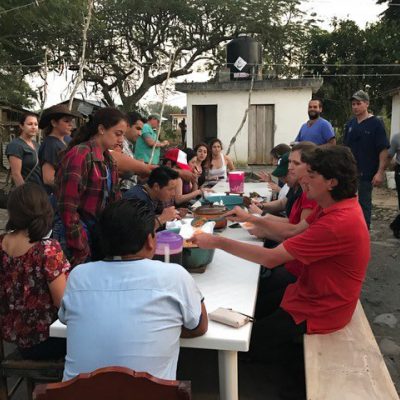
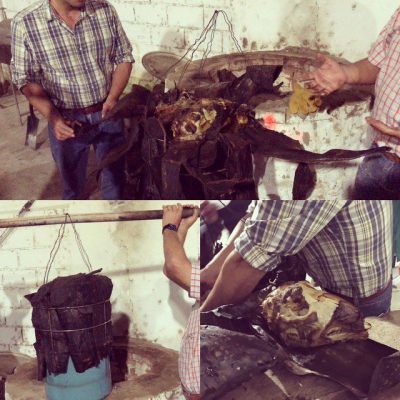
Day 5
By Lauren Kustasz
Today, we woke up, left the ranch around 8:00 a.m., and ate breakfast at our usual spot. Then, we left for a community named Laguna de Farfán. The drive was long, about two-and-a-half hours, and toward the end, it was quite bumpy on twisty-hilly roads. After driving for about two hours, we were making our way up a mountain when we reached a steep hill. It had rained a lot the night before, so everything was wet and the road was a dirt road at this point, so the ground was soft. The first van carrying the students from UNAM gunned it and tried to make it up the steep hill, but had no luck as the wheels spun in the slick dirt. Dr. Arturo, one of the veterinarians at the Donkey Sanctuary, who was driving this van, decided to try it without any passengers to lighten up the load. Even with no people and five of us trying to push the van, the attempt did not work and we were stuck. Since the sun was just beginning to shine on the road, we decided to wait a bit to let the dirt road dry, and then try to make it up the hill.
To fill in the lost time, Dr. Bunn and Dr. Arturo delivered an impromptu lesson about farrier work along the side of the road. It was a cool “classroom” lesson with a beautiful backdrop of the green mountainous terrain and a few cows grazing below us. As Dr. Bunn and Dr. Arturo began showing us their instruments and talking about the importance of balancing feet, José, our wonderful interpreter, was standing nearby interpreting for us when he realized he had been standing on an anthill the entire time. It was probably one of the funniest moments of the trip thus far! José starting jumping around slapping at his legs and eventually had to run behind the van and completely undress to get all of the ants off his clothes. Luckily, our other awesome interpreter, Humberto, was ready to jump in and continue the lesson for us as José ridded himself of the ants (we could not stop laughing). After this lesson, the road had dried up enough for us to make another attempt to drive up the hill, and this time we were victorious! In our van, we like to chant every time our driver, Luis, makes it past a rough spot in the road, so when we made it up this steep hill, our van was filled with our voices chanting "LUIS! LUIS! LUIS!"
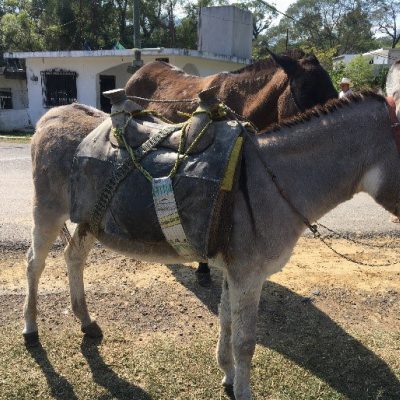
When we finally arrived at the community (a couple of hours late), there were many horses, donkeys, and mules waiting for us. These equids did all types of work, mostly carrying loads and people, and were used in hilly terrain. Since this was our second day in the field, we had a better idea of how to organize things, so we split up into groups of four to do physical exams, farrier work, dental work, and castrations. At the end of the day, we saw about 120 equids and did a handful of dentals, a dozen or so feet, and three castrations. The community members were very gracious for our services, although some were frustrated with the amount of time they had spent waiting (this was understandable considering that some of them traveled many hours to get to us). The students working with Dr. Bunn doing farrier work said that compared to the community the day before, these equids had much harder feet (this is a very good thing for working equids because it leads to less feet problems and less lameness). Most of the equids in this community were very well behaved, and did not mind having us work on them. There were, of course, a couple that gave us troubles, including two nervous mules and a rambunctious foal, among others. Throughout the day, we got to listen to a hilarious parrot yelling “Hola” and singing La Cucaracha from a home nearby.

As a part of this externship, each of us had to choose a topic to study while we were here. Since I am very interested in ophthalmology, I decided to do my project on determining the types of eye problems that are common in this region of Mexico. I got to see my second ophtho case while at this community. It was a horse with a non-painful, but injured, eye. Dr. Schott helped me do an examination of the eye, and we found that its retina still functioned; however, it did not have a reliable menace response (probably due to all of the corneal scarring). The owner told us that about a year ago, the horse had been out on the field, and when it came back, its eye was injured. Since the eye was non-painful and the owner told us that it never seemed to bother the horse, we determined to leave it alone. If the eye had been painful, or was painful at certain times (like with anterior uveitis), we would have likely performed an enucleation.
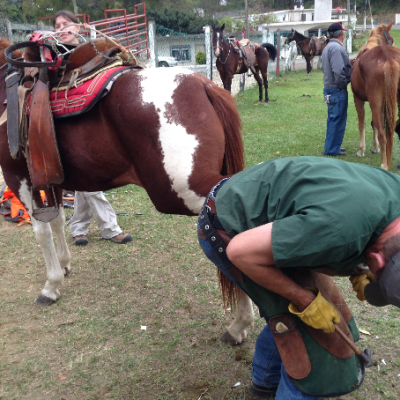
The day ended late (around 8:00 p.m.) because we got such a late start, and the General started the day with castrations and ended by doing dentals in the dark. While we were waiting to go eat dinner, a couple of us MSU students sat in the van with Roberto (a veterinarian with the Donkey Sanctuary), Humberto, and Bernie (one of the students from UNAM). We traded some English and Spanish tongue-twisters and played charades. It was a lot of fun, and was a really good chance for us to bond with each other.
We ended the day by eating dinner at a community member’s home and watching a fútbol game in an adjacent covered asphalt court. The dinner was rather unique because there were about 25 of us there to eat, and they only had one dinner table with eight chairs. So, we just took turns at the dinner table and conversed while others were eating. It is really cool to get to spend time in peoples´ homes and experience their culture. Everyone here is so nice, and they make you feel like a part of their family. It is really neat and it warms your heart. We got back to the ranch around 1:00 a.m., and we all went right to sleep after a long day of work and traveling.
Day 6
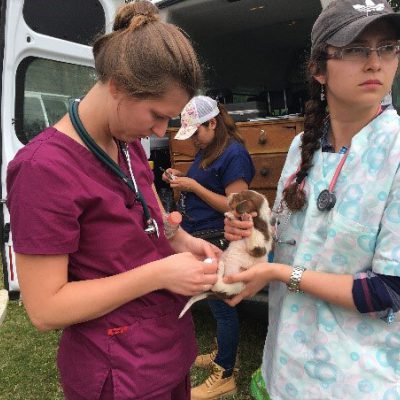
By Emily Thomas
Friday was another great day! It was our third day going into communities and treating horses and donkeys (and a puppy!). After a stop at our breakfast buffet restaurant, we headed back up into the Veracruz hills. The community we visited was Colipa. It was a beautiful little town in a very hilly area. Here, we mostly saw horses that were used for riding and some ranch work, and also a fair number of burros used for transport of goods and people. Interestingly, many of the horses also were used for an annual all-day ride (and party) between several of the communities—over 3,000 horses participate in this ride each year.
Our team broke into groups to begin doing physical exams, castrations, farrier work, dentistry, and educating members of the community on proper harness fit. Today was the largest number of castrations, keeping the General and Dr. Jeff busy, and providing many of us an opportunity to assist with our first castration.
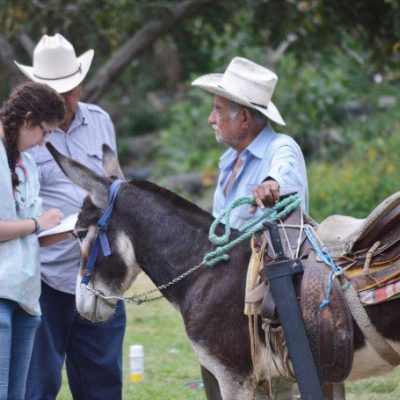
Our groups were working fairly well by now and in addition to castrations, a number of us got quite involved in farrier work. Friday was a really meaningful day for me personally, as I did my first castration. I also learned first-hand about field anesthesia as I went down with my horse. I broke my glasses, but was otherwise unhurt. I also felt my first pregnancy on rectal palpation, and I noticed a lot of improvement in how I approached nervous horses and donkeys. I am learning a lot about handling and behavior, and I am much more comfortable vaccinating horses that are not really happy to be handled, let alone stuck with needles.
As the day wore on, a group of community children started playing soccer. We were working on their soccer field, but we were too tired to join in. At the end of the day, we were once again fed by the community. They set up a long table in one of their homes and served us a great chicken soup with beans and tortillas. After dinner, it was time for a group photo in the local town square before heading home for our last night at the Veracruz ranch.
Days 7–8
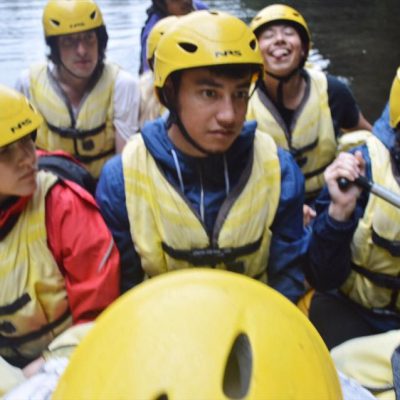
By Alex Pollock
After a fulfilling first week of work, we were all ready for some down time. After a quick stop at the cheese shop at the Veracruz UNAM ranch, we bid farewell to the ranch and headed to breakfast as a group, MSU and UNAM students and the Donkey Sanctuary staff. After breakfast, our Veracruz UNAM ranch hosts, Manuel and Ivette (UNAM ranch faculty) took us to Cascada El Encanto in Atzalan, a waterfall upstream from the river that flows through the UNAM ranch. Here we piled into 10 person rafts and paddled a short way upstream to a beautiful waterfall! Some of us were adventurous enough to jump into the water and swim right up to the falls. The water was refreshing and much warmer than whitewater rafting rivers in the US. After our visit to the waterfall, we drove a short way and stopped at a beautiful look out spot where we warmed up with coffee, and Roberto, a recent UNAM graduate that is now a veterinarian for the Donkey Sanctuary, showed us the basics of salsa dancing. After that, we started the four-hour drive to the Port of Veracruz, where we were looking forward to a day of relaxing on the beach. We arrived at our hotel around 9:00 p.m., washed up quickly, and went for a late dinner at Bennigan's.
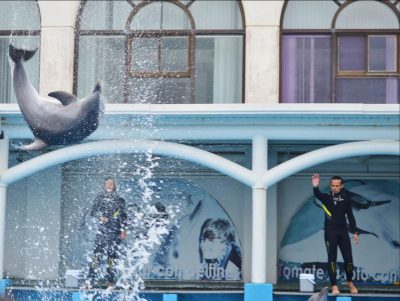
Sunday was our designated "free day," and most of us took the opportunity to sleep in a bit longer. Unfortunately, the wind was blowing quite hard and the waves were high, so a beach day was out of the question. As an alternative, some of us went to the Veracruz Aquarium, regarded to be the best in Latin America (it was very good with a shark tube and a dolphin show). In the afternoon, we divided into two groups: one group explored the Port of Veracruz and did some shopping, and the other group traveled to an ancient fort called San Juan de Ulúa. Dr. Schott even managed to catch the afternoon win by the MSU men's basketball team over the Wolverines, and we taught our Mexican colleagues the importance of “Go Green!” Around 6:00 p.m., we reassembled and went to a restaurant for a delicious seafood dinner in Veracruz City. We ate a range of dishes, from sea snails to octopus to whole grilled fish, all caught in the Gulf of Mexico. After dinner, the students worked our dinner off as we "salsa'd" the night away while the remainder of the group enjoyed a tequila! Our dance lessons from Roberto definitely came in handy!
Overall, the weekend was truly unforgettable. Communication between MSU and UNAM professors and students and Donkey Sanctuary staff was continuously flowing as new friendships were forged that will last long into our future careers as veterinarians.




